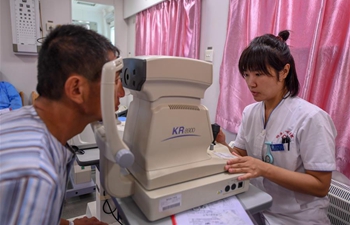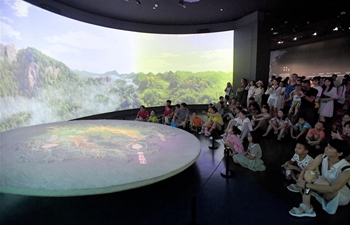LOS ANGELES, July 24 (Xinhua) -- A team of NASA engineers recently delivered critical hardware for the European Space Agency (ESA)'s Euclid mission, set to launch in 2022 to investigate two of the biggest mysteries in modern astronomy: dark matter and dark energy, according to a release of NASA's Jet Propulsion Laboratory (JPL) on Tuesday.
Based at JPL in Pasadena, California, and the Goddard Space Flight Center in Greenbelt, Maryland, the engineers designed, fabricated and tested 20 pieces of sensor-chip electronics (SCEs) hardware for Euclid.
These parts, which operate at minus 213 degrees Fahrenheit (minus 136 degrees Celsius), are responsible for precisely amplifying and digitizing the tiny signals from the light detectors in Euclid's Near Infrared Spectrometer and Photometer (NISP) instrument. The Euclid observatory will also carry a visible-light imaging instrument.
According to JPL, 18 SCEs have been delivered to the ESA, and two more will soon be on their way. The detector system will undergo extensive testing ahead of launch.
"Even under the best of circumstances, it is extremely challenging to design and build very sensitive and complex electronics that function reliably at very cold operating temperatures," said Moshe Pniel, the U.S. project manager for Euclid at JPL, who led the team that delivered the sensor-chip electronics.
"Euclid will conduct a survey of billions of distant galaxies, which are moving away from us at a faster and faster rate as the expansion of space itself accelerates," said JPL.
Scientists do not know what causes this accelerating expansion but have named the source of this phenomenon dark energy. By observing the effect of dark energy on the distribution of a large population of galaxies, scientists will try to narrow down what could possibly be driving this mysterious phenomenon.
In addition, Euclid will provide insights into the mystery of dark matter. According to JPL, dark matter is five times more prevalent in the universe than the "regular" matter that makes up planets, stars and everything else people can see in the universe.
To detect dark matter, scientists look for the effects of its gravity. Euclid's census of distant galaxies will reveal how the large-scale structure of the universe is shaped by the interplay of regular matter, dark matter and dark energy.
This will allow scientists to learn more about the properties and effects of both dark matter and dark energy in the universe, and to get closer to understanding their fundamental nature, said JPL.



















